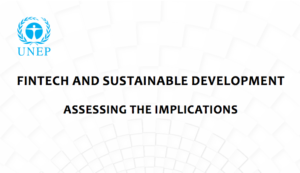
Green Finance And How Fintech Can Enable Sustainable Development
by Fintech News Singapore May 24, 2017In 2015, the United Nations’ 195 member countries adopted their Sustainable Development Goals (SDGs) and committed to the global transition from the fossil-fueled industrial era to low-carbon, knowledge-richer, green economies.
But this change depends in part on a reset of the global financial system to ensure that private capital is redeployed to finance the transition to an inclusive, green economy. It requires reforming incumbent finance and democratizing such services to drive this global transition toward accessible green technologies, jobs and infrastructure.
According to Patrick Njoroge, the governor of the Central Bank of Kenya, innovations in fintech offer “the greatest hope for aligning the world’s financial systems with the urgent twin objectives of sustainable development and deepening financial inclusion.”
 By reducing costs and boosting efficiency, fintech mobilizes green finance, enables poorer people to access clean energy through innovative payment systems and facilitate free savings for rich and poor alike. That’s what claims the Fintech and Sustainable Development report, a document published in December 2016 by the United Nations Environment Programme (UNEP).
By reducing costs and boosting efficiency, fintech mobilizes green finance, enables poorer people to access clean energy through innovative payment systems and facilitate free savings for rich and poor alike. That’s what claims the Fintech and Sustainable Development report, a document published in December 2016 by the United Nations Environment Programme (UNEP).
According to the report, the challenge for financial systems is twofold: to mobilize finance for specific sustainable development priorities and to mainstream sustainable development factors across financial decision-making.
“Capital needs to be mobilized for financial inclusion of underserved groups, raising capital for sustainable and resilient infrastructure and financing critical areas of innovation,” it reads. “Sustainability also needs to be incorporated into the performance disclosure and reporting.”
Combining the IoT, blockchain and AI

Image credit: Bitcoin keychains by BTC Keychain, via Flickr
The report suggests a number of recommendations to design a sustainable financial system. Notably, it claims that the combination of the Internet-of-Things (IoT), blockchain technology and artificial intelligence (AI), if deployed correctly, will enable the sustainable development agenda.
While IoT and AI will enable the “animation of the physical world,” blockchain’s smart contracts on an immutable distributed ledger will allow real economy assets, infrastructures and processes to interact with the financial system in predictable ways and with business models that were unheard of ten years ago.
The report recommends the creation of a FT4SD (fintech for sustainable development) challenge fund, which would provide startups with the design, technical support and funding to develop implementable pilot plans.
It also suggests setting up regional FT4SD innovation incubators for multi-stakeholder partnerships. This would allow governments, international development partners, NGOs, scientific organizations, private sector companies, central banks, fintech startups and incumbent financial institutions to convene place-specific and time-bound “co-creation labs” to design specific FT4SD capabilities.
China and green finance
Financial centers from all around the world have issued strategies for greening their financial systems, and set out plans to seize the green finance opportunity. One particular country is China, which launched a 35-point program in September 2016 to establish a green financial system.
 Separately, China’s leading online and mobile financial services provider Ant Financial joined hands with UN Environment earlier this year to launch the Green Digital Finance Alliance. The initiative aims to harness digital technologies in catalyzing financing that addresses global environmental challenges.
Separately, China’s leading online and mobile financial services provider Ant Financial joined hands with UN Environment earlier this year to launch the Green Digital Finance Alliance. The initiative aims to harness digital technologies in catalyzing financing that addresses global environmental challenges.
Commenting on the launch, Eric Jing, CEO of Ant Financial, said:
“Ant Financial is a strong believer in green finance. Several of our products and services have been contributing to sustainable development. Leveraging mobile Internet, cloud computing and big data, we can encourage our hundreds of millions of users to participate in a green lifestyle.”
One such innovation is the Ant Financial app which provides its users with a carbon account alongside their credit and saving accounts. This gives the company’s 450 million users in China the ability to benchmark their carbon footprint – generated through analysis of their financial transaction history – and earn “green energy” credits for reducing their footprint.
Ant Financial has integrated this into a social media experience as well as committed to a complementary tree-planting carbon offset program. As of today, 72 million users are participating in the app.
Beyond China, ingenious startups have developed innovative solutions to contribute to the green finance movement and committed to a more eco-friendly and ethical way of doing business. In Sweden, Trine seeks to end “energy poverty” by providing a digital investment platform to allow private investors to locate and fund solar energy projects in emerging economies. In Kenya, M-KOPA is leveraging the successful domestic mobile payments platform M-PESA to sell solar power systems to poorer communities.
Featured image via Pixabay.







